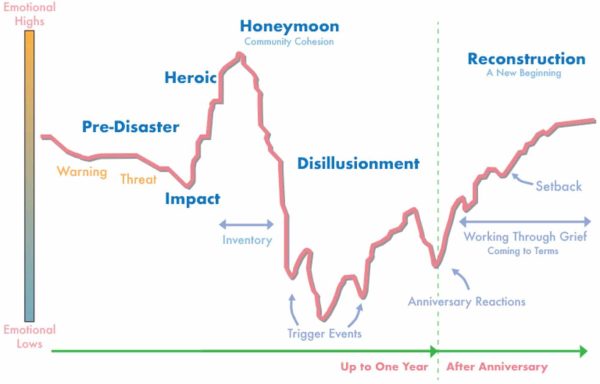Listen to this blog (4 mins)
When developing disaster recovery plans, school officials should note that mental health is one of the most important elements of disaster recovery. However, most districts do not have enough qualified staff or resources to assist those who were emotionally harmed by the disaster.
Dr. CJ Huff, former superintendent for Joplin School District in Missouri, is credited for bringing his school district and community together after a devastating tornado killed over 160 people in the city—including a student in his district—and damaged 19 school buildings. Dr. Huff discussed lessons learned from this tragedy and the emotional lifecycle following a disaster in a recent Raptor webinar. A summary is below. You can watch the full webinar on-demand here.
Supporting Communities Through Their Recovery Process
“From a leadership standpoint,” Dr. Huff advises, “We have to take into account the emotional state of the people that we’re leading. That includes our internal staff as well as our external stakeholders and the impact that this recovery’s having on everyone.”

Regardless of whether communities are dealing with a hurricane, wildfire, or the COVID-19 pandemic, there are similarities in the recovery processes of each type of disaster. Here are the 6 stages in the emotional lifecycle following a disaster:
- Pre-Disaster: The pre-disaster stage consists of the warning/threat of an impending disaster, such as bracing for an incoming hurricane. During this stage, emotions tend to be on the higher end of the scale, as people prepare for the disaster to occur.
- Impact: The impact stage is associated with “anxiety and angst, and [it is here that we] start to see a little… dip in people’s emotional state,” Dr. Huff explains.
- Heroic: During this stage, emotions skyrocket. Billboards, banners, signs, and t-shirts are created to promote the need for assistance, and people come together to support each other through the initial recovery.
- Honeymoon: Dr. Huff describes the honeymoon stage as “short-lived.” This stage is associated with community cohesion and it’s common for people to believe that their community will be fully recovered soon, so long as they continue to work together.
- Disillusionment: This is the longest stage of recovery, and it occurs when people put in a lot of hard work but become uncertain of when they’ll be finished. This is also the stage where emotional levels reach their lowest, as people begin feeling discouraged.
- Reconstruction: During this final stage, communities learn how to come back stronger, and emotions are higher than they were during the pre-disaster stage.
“As we move through this recovery effort, [schools] spend more time listening, building relationships in the community, spending time in the community, talking to people and helping them understand the challenges that we have as leaders, but also listening to their concerns,” Dr. Huff shares. It’s through all of this that communities are able to come back stronger than before.
Learn More
Dr. CJ Huff says, “When emotion and logic collide, emotion wins every single time. We have to be cognizant of that as we work through [recovery].”
To hear the rest of the conversation and continue learning directly from Dr. Huff and other safety experts, make sure to listen to the on-demand webinar.
To learn more about Raptor, contact us today for a personalized demo.





